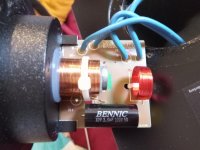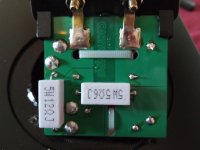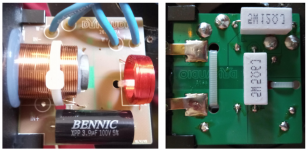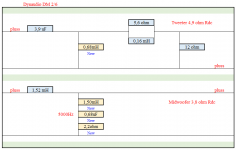 Dear All,
Dear All, After my first pair of Dynaudio Emit M10 (black) got paint (crack) problems I got a new pair from the shop I bought them from.
Very nice as they where 11 mounts old already.
I hesitate to open the box as I found something objectionable about them after having used them for a while.
They sound "crispy" as a permanent character on what ever you play on them
once noticed it is hard to ignore.
Even Martin Colloms review mentions this character.
Other that this they have many good qualities.
I wonder if it would be worth upgrading the tweeter caps to get rid of the crispy-Ness or could it be elsewhere in the frequency range?
Any input on this would be greatly appreciated!
Last edited:
Once a friend told me that to avoid it, he places a small incandescent lamp i series with the tweeter. so, when the lamp warms increases its resistance and creates a better tone balance. I never use it as I have biamplification (Separate amplifiers for high and low frequencies). It is easy, so why not to try it? You will need to tray several lamps to arrive to the one of your taste.
Thanks for the nice crossover board photo! Tweeter sounding crispy is more of a driver quality and less of a filter property. I don't see a padding resistor in the circuit, so either it's a specially designed driver unit that needs no sound padding, or it's voiced in a way that some might find it too bright. I do not have any measurement data on these, so I can't tell.
SoundStageNetwork.com | SoundStage.com - SoundStageNetwork.com | SoundStage.com
Treble looks to be elevated 1-2 dB. Original padding appears to be post-filter, so maybe an additional resistor in parallel with the tweeter.
Treble looks to be elevated 1-2 dB. Original padding appears to be post-filter, so maybe an additional resistor in parallel with the tweeter.
The elevated treble suggest Dynaudio may have designed them more for placement on a desk/console/cabinet rather than out in the room on stands.
From Dynaudio's site: "..optimised for smaller and mid-size rooms, and our designers have made sure they’ll still work shoved up against a wall or on a shelf"
A compact bookshelf speaker - Award-winning Emit 10 - Dynaudio
From Dynaudio's site: "..optimised for smaller and mid-size rooms, and our designers have made sure they’ll still work shoved up against a wall or on a shelf"
A compact bookshelf speaker - Award-winning Emit 10 - Dynaudio
The emit 10 represent more of a departure from the classic dynaudio "house sound". While they do have some extra bite in the mid treble I don't find it bothersome for the most part, It actually works in its favor on some material, though hotly recorded rock and pop can make this quality of the speaker a bit much.
The shining quality of this speaker to me is the midrange projection and tone. In that area it is in some ways more involving to listen to than the focus 110. The focus having more of the classic even handed dynaudio sound. The focus has better imaging. Imaging on the emit is good but not exceptional. At the price and even beyond they do a good job of putting the music across. While they will not be confused for a top class monitor, I think they are overall a very good mid priced speaker.
Another area where they differ from classic dynaudio qualities is that they don't need gobs of power or be turned up to shine. In that respect they are almost the inverse of the focus 110, which loses some of its verve below moderately loud levels, it's been said of the 110's and it is mostly true, they sound really good and stay composed when you crank them. Conversely the emit 10 loses its composure and the port stars getting a little funky when cranked loud. Also the port output on both speakers (and really all Dynaudio speakers) is pretty healthy and therefore do better away from wall.
The shining quality of this speaker to me is the midrange projection and tone. In that area it is in some ways more involving to listen to than the focus 110. The focus having more of the classic even handed dynaudio sound. The focus has better imaging. Imaging on the emit is good but not exceptional. At the price and even beyond they do a good job of putting the music across. While they will not be confused for a top class monitor, I think they are overall a very good mid priced speaker.
Another area where they differ from classic dynaudio qualities is that they don't need gobs of power or be turned up to shine. In that respect they are almost the inverse of the focus 110, which loses some of its verve below moderately loud levels, it's been said of the 110's and it is mostly true, they sound really good and stay composed when you crank them. Conversely the emit 10 loses its composure and the port stars getting a little funky when cranked loud. Also the port output on both speakers (and really all Dynaudio speakers) is pretty healthy and therefore do better away from wall.
I have'nt popped mine open but was wondering if anyone knows whether the emit 10's use a straight 1st order network without the additional zobel impedance correction board Dynaudio typically uses.There are resistors on the other side of the board, one parallel to a coil possibly BFC.
Lojzek, the tweeter is actually 1st order, as you can see from the pictures. The coil is in series with the tweeter, and I think the coil's job is to take down the rising FR of this newer, quicker and lighter type of Dynaudio tweeter.
I have the 1st version of the M10, the Dynaudio DM 2/6, with identical filter and drivers. And I was also bothered with this unnatural "crispy" sound coming from somewhere in the lower treble area.
First I damped the tweeter's flimsy plastic back chamber with 4mm bitumen on the outside, but the "crispy" sound was still present. Then I disconnected the tweeter, and guess what; the "crispy" sound still stood out, although a little weaker (difficult to "ear-measure" things like this when the tweeter is disconnected).
I then looked at FR-plots of other 5½" Dynaudio midwoofers, both Dynaudios own and Stereophile measurements of Totem speakers ++, and most of them had a 8-10dB peaky breakup-resonans around 5000Hz, with lots of stored energy on the waterfall plots. I 1st order filter is not enough. So, in went a deep and narrow 5kHz notch, and after some minor adjustmensts … problem solved.
But with the notch in place, the presence region was too recessed. So I increased the tweeter's filter from 1st to 2nd order. I estimated(!) that this change would increase the damping from around 15dB to 25dB at 1000Hz, reducing the IMD coming from the tweeter, and at the same time lift the tweeter's FR some 1-2dB in the 3000-6000Hz range. And with a 1st order on the midwoofer and 2nd on the tweeter, I also hoped that the phase tracking would improve as well, leading to more precise imaging.
And when I was on it, or in it, I damped the whole cabinet with 4-8mm bitumen pads, and had some nice looking, real cherry-veneer on the outside.
The DM 2/6 is is a great little speaker as is, with very good up-to-date drivers and a well built Made in Denmark ¾" MDF cabinet with a 1" baffle. With all the mods in place, I think it sounds even "better" than my old ProAc 1sc, and I wasn't expecting that. The DM 2/6 has more meat and colour in the bass and lower midrange, it sounds more real at lower volumes, and the treble is cleaner, it doesn't have the 1sc's "stressed" top end. But the 1sc's midrange is hard to beat.
I have the 1st version of the M10, the Dynaudio DM 2/6, with identical filter and drivers. And I was also bothered with this unnatural "crispy" sound coming from somewhere in the lower treble area.
First I damped the tweeter's flimsy plastic back chamber with 4mm bitumen on the outside, but the "crispy" sound was still present. Then I disconnected the tweeter, and guess what; the "crispy" sound still stood out, although a little weaker (difficult to "ear-measure" things like this when the tweeter is disconnected).
I then looked at FR-plots of other 5½" Dynaudio midwoofers, both Dynaudios own and Stereophile measurements of Totem speakers ++, and most of them had a 8-10dB peaky breakup-resonans around 5000Hz, with lots of stored energy on the waterfall plots. I 1st order filter is not enough. So, in went a deep and narrow 5kHz notch, and after some minor adjustmensts … problem solved.
But with the notch in place, the presence region was too recessed. So I increased the tweeter's filter from 1st to 2nd order. I estimated(!) that this change would increase the damping from around 15dB to 25dB at 1000Hz, reducing the IMD coming from the tweeter, and at the same time lift the tweeter's FR some 1-2dB in the 3000-6000Hz range. And with a 1st order on the midwoofer and 2nd on the tweeter, I also hoped that the phase tracking would improve as well, leading to more precise imaging.
And when I was on it, or in it, I damped the whole cabinet with 4-8mm bitumen pads, and had some nice looking, real cherry-veneer on the outside.
The DM 2/6 is is a great little speaker as is, with very good up-to-date drivers and a well built Made in Denmark ¾" MDF cabinet with a 1" baffle. With all the mods in place, I think it sounds even "better" than my old ProAc 1sc, and I wasn't expecting that. The DM 2/6 has more meat and colour in the bass and lower midrange, it sounds more real at lower volumes, and the treble is cleaner, it doesn't have the 1sc's "stressed" top end. But the 1sc's midrange is hard to beat.
Attachments
Treble not that crispy
I too found the emit m10 a bit harsh to listen to for longer periods so I tried changing the tweeter caps with Mundorf Supreme Evo Oil. I changed the resistors as well. So The result is that the harshness that was irritating was gone. The tonal balance didnt change but it seems the Bennic caps do something to the signal that rubs me the wrong way
I too found the emit m10 a bit harsh to listen to for longer periods so I tried changing the tweeter caps with Mundorf Supreme Evo Oil. I changed the resistors as well. So The result is that the harshness that was irritating was gone. The tonal balance didnt change but it seems the Bennic caps do something to the signal that rubs me the wrong way
- Home
- Loudspeakers
- Multi-Way
- Crispy sounding Dynaudio Emit M10



